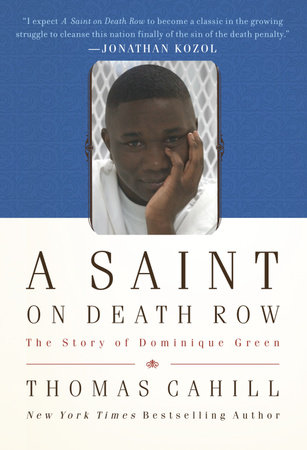A Saint on Death Row Reader’s Guide
By Thomas Cahill


1. Dominique Green bore the emotional and physical scars of his mother’s abuse and was estranged at times from his father, yet Dominique displayed extraordinary parenting skills, giving powerful guidance to his brothers and his fellow inmates. How would you answer the question Thomas Cahill poses in chapter one: “How did Dominique … evolve into the expansive human being he became if all his early experiences were negative?” How might what Dominique learned be implemented with other at-risk youth?
2. For Dominique and thousands of other youths, the juvenile justice system became a mandatory home. Does it appear as though there is any kind of support structure for the children in this system, and is enough done to prepare children in the system for life on the outside? How would you characterize the family Dominique created for himself inside prison?
3. Near the end of his life, Dominique hoped that Shelia could teach Stephanie how to be a mother. Was his hope realistic? Would having a mentor, someone to teach parenting, help in abusive situations such as the ones Dominique and Stephanie found themselves in?
4. In his poem “What does hate create,” reprinted in chapter one, Dominique describes how it feels when “nobody does anything/nobody utters a peep” while he is raped. Though sexual abuse of minors in Texas’s juvenile corrections facilities has received significant media attention, his poem raises the broader question of child neglect. How can this sort of abuse be prevented? Is there any way to readjust societal norms so that institutional abuse of children is never tolerated? What would it take to fund foster programs and sufficient numbers of child advocates in your community?
5. Cahill describes blooming flowers as a reflection of Dominique’s journey to adulthood. What legacy has Dominique left for his younger brothers? What did he teach them about becoming a good man?
6. In chapter six, Cahill expresses frustration at those who miss the point of Dominique’s experience. The question, Cahill says, was not whether Dominique was guilty but whether he got a fair trial. What are the best responses to those who believe that the poor receive sufficient legal representation?
7. Chapter two includes a quote from the Los Angeles Times in which Judge Shaver, who presided over Dominique’s trial, says, “The Constitution says everyone’s entitled to the lawyer of their choice, and Mr. Benn was their choice. The Constitution doesn’t say the lawyer has to be awake.” Chapter four reveals that Sheila Murphy could not serve as Dominique’s principal attorney because his existing counsel could only be removed by court order. What would it take to mandate high standards for public defenders in your community?
8. If you had served on Dominique’s jury, how would you have reacted to the case presented by the prosecutor?
9. Discuss Texas’s “law of parties,” described in chapter two, which allows accomplices to be convicted of capital murder even if they did not actually commit the murder. Do you believe that the law is constitutional? If a Texas legislator proposed to repeal that law, could he or she stand a chance of getting reelected?
10. Dominique loved listening to news programs, but Cahill describes incidents in which the media distorted or omitted key facts about his case (see chapter five). In what ways is the struggle for justice a struggle for publicity? What is the best way to serve as a media watchdog?
11. Dominique said that he never expected his rosary, whose beads represented friends, mentors, or spiritual guides who had been executed, to grow so long. He chose to stop adding beads at 101. A rosary is typically used for counting prayers; what does Dominique’s rosary say about his approach to prayer?
12. How was Dominique able to keep his faith from being extinguished despite a lifetime of hardship (including sexual abuse by a priest at his Catholic elementary school)?
13. Dominique was transformed by Desmond Tutu’s No Future Without Forgiveness, in which the former archbishop of Cape Town describes chairing South Africa’s Truth and Reconciliation Commission. How did Dominique exemplify the commission’s principles? How do these principles compare with the image of a God who orders sinners to suffer?
14. Discuss the book’s title. Who were the saints and the sinners along Dominique’s road to execution?
15. Did A Saint on Death Row change your beliefs about the nature of suffering in the world, and the nature of joy and love, good and evil? If so, how?
16. How did you react to the anthology produced by Dominique and his fellow inmates? What insights did you gain from their voices?
17. Cahill begins the first chapter by observing that Dominique was born less than four months after the birth of Cahill’s first child. In a similar exercise, compare your childhood to Dominique’s, in terms of family life, education, culture, comfort, and other factors. If you had been born into Dominique’s family, where would you be today?
18. The widow of Andrew Lastrapes, along with their sons, vocally opposed Dominique’s execution. Groups such as Murder Victims’ Families for Reconciliation (www.mvfr.org) oppose the death penalty in all cases. How was a bridge built between Dominique and the Lastrapes family? What distinguishes families like the Lastrapeses and those survivors who approve of capital punishment?
19. Dominique’s team of supporters came to include Stefania Caterina and others from around the globe. How do cases like Dominique’s—and the existence of capital punishment in general—affect America’s standing in the world?
20. Discuss Jessica’s role in Dominique’s life. What factors led her to such an accomplished adulthood? What could she and Dominique have accomplished together if he had been raised in different circumstances?
(For a complete list of available reading group guides, and to sign up for the Reading Group Center enewsletter, visit www.readinggroupcenter.com)
Just for joining you’ll get personalized recommendations on your dashboard daily and features only for members.
Find Out More Join Now Sign In